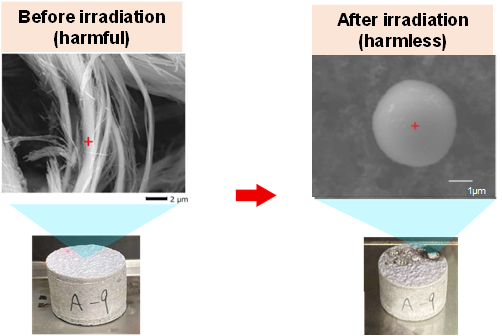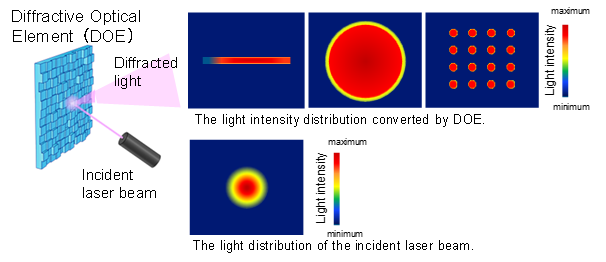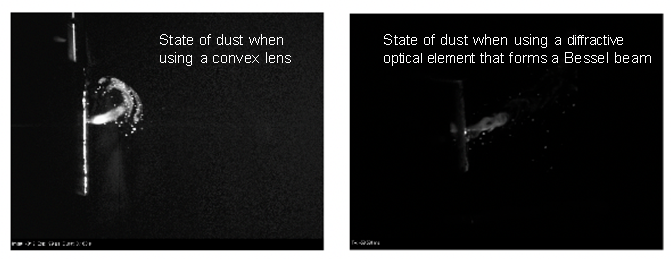Microsoft ends support for Internet Explorer on June 16, 2022.
We recommend using one of the browsers listed below.
- Microsoft Edge(Latest version)
- Mozilla Firefox(Latest version)
- Google Chrome(Latest version)
- Apple Safari(Latest version)
Please contact your browser provider for download and installation instructions.
January 21, 2022
The world's first detoxification of asbestos and dust control achieved by high-power laser irradiation
The technology to avoid health risks for asbestos demolition workers
Nippon Telegraph and Telephone Corporation (NTT, President & CEO: Jun Sawada) has confirmed that asbestos1 can be transformed from a fiber shape to a spherical shape by irradiation with a high-power laser. Furthermore, NTT has developed a technology that suppresses the scattering of asbestos dust due to laser irradiation using a diffractive optical element (DOE). In the general process of removing asbestos building materials, there are some risks of causing diseases such as lung cancer and malignant mesothelioma to workers by inhaling harmful asbestos dust. By using this technology, asbestos can be transformed into a harmless spherical shape2 and the amount of scattered dust can be suppressed, which can significantly reduce the health risk of workers.
1. Background
Asbestos has been widely used as a heat insulating material for buildings, but the problem of causing lung cancer and malignant mesothelioma when inhaled by humans has become widely known, and its use is now prohibited in many countries. It is considered that the main reason why asbestos is harmful is its extremely fine and pointed shape. It has been pointed out that it easily deposits in the alveoli of lung when asbestos is inhaled into the human body, damaging the lung tissue for a long time, causing genetic abnormalities, and causing cells to become cancerous.
Although asbestos removal due to the dismantling of aging buildings has been increasing year by year, the current asbestos removal tools such as electric tools disperse harmful dust to the surroundings. Therefore, protection measures against dust exposure3 is necessary to avoid asbestos scattering around workers and work sites. In order to fundamentally avoid the exposure risk, asbestos removal technologies that detoxifies harmful dust is required.
2. Technology feature
High-power lasers were expected to change the shape of asbestos by thermal melting at the irradiation point. NTT conducted a laser irradiation experiment and confirmed for the first time in the world that the shape of asbestos changed (Fig. 1). Figure 1 shows the result of the observation and demonstration that the shape of asbestos has changed by actual laser irradiation.
In addition, by controlling the power density and beam shape of the high-power laser that irradiates the asbestos-containing coating material using a diffractive optical element, we have succeeded in suppressing the amount of dust during laser irradiation. A diffractive optical element is a device that can freely change the shape of a laser beam by utilizing the diffraction phenomenon of light (Fig. 2). By forming the laser beam into a Bessel beam4 with a diffractive optical element and significantly suppressing the amount of dust scattered during laser irradiation, the risk of exposure to asbestos dust is further reduced (Fig. 3, right side: When molded into a Bessel beam and irradiated).
 Figure 1. Example of melting asbestos contained in building materials.
Figure 1. Example of melting asbestos contained in building materials.
(The harmful fiber shape disappears and it changes to a harmless spherical shape.)
 Figure 2. Example of beam shape control by diffractive optical element.
Figure 2. Example of beam shape control by diffractive optical element.
(Input light can be converted into various beam shapes and power densities.)
 Figure 3. Dust suppression effect of diffractive optical element.
Figure 3. Dust suppression effect of diffractive optical element.
(White smoke-like dust generated from the laser irradiation point.)
3. Future Perspective
NTT has realized a diffractive optical element compatible with a high-power laser of 10 kW class using silicon, which is a low-cost material, and it is possible to reduce the cost of the laser irradiation device for asbestos detoxification. In addition, by using a diffractive optical element, the laser head can be made lighter and smaller, and it will be possible to bring it to places where the asbestos removal is difficult with conventional construction methods, such as narrow places and ceilings.
Toward the realization of such a laser tool, NTT will develop technologies using a diffractive optical element that can detoxify and remove asbestos-containing coating materials in the shortest time by expanding the irradiation range of the light beam, and them that can cut building materials including asbestos safely and efficiently by forming the laser beam into a linear shape. NTT will contribute to realize environmental conservation through the development of safe asbestos removal technology.
The contents of this technology will be announced at SPIE (The international society for optics and photonics) Photonics West On-demand, which will be held from February 21st to 27th, 2022.
1Asbestos is a general term for naturally occurring fibrous silicate minerals, and is known as serpentine and amphibole. Since asbestos fibers have an extremely fine fibrous structure, they are easily inhaled and deposited in the human alveoli, and it is said that the thinner and longer ones are more harmful. When deposited in the alveoli, it causes inflammation for a long time, and the tissue of the lungs continues to be damaged, causing genetic abnormalities and causing cells to become cancerous. (Source: https://www.erca.go.jp/asbestos/what/higai/mechanism.html)
2If the fiber shape, which is considered to be the main reason for its harmfulness, is transformed into a spherical shape, it deviates from the definition of asbestos, so it is considered to be detoxified.
3Exposure to risk factors such as pathogenic microorganisms, drugs and chemicals is called exposure.
4Bessel beam is a type of non-diffraction beam in which the beam does not spread due to the diffraction phenomenon, and has the characteristic that the intensity distribution does not change depending on the irradiation distance.
About NTT
NTT believes in resolving social issues through our business operations by applying technology for good. We help clients accelerate growth and innovate for current and new business models. Our services include digital business consulting, technology and managed services for cybersecurity, applications, workplace, cloud, data center and networks all supported by our deep industry expertise and innovation. As a top 5 global technology and business solutions provider, our diverse teams operate in 80+ countries and regions and deliver services to over 190 of them. We serve over 80% of Fortune Global 100 companies and thousands of other clients and communities around the world. For more information on NTT, visit www.global.ntt/
.
Media Contact
NTT Information Network Laboratory Group
Planning Department, Public Relations Section
E-mail: inlg-pr-pb-ml@hco.ntt.co.jp
Information is current as of the date of issue of the individual press release.
Please be advised that information may be outdated after that point.
NTT STORY
WEB media that thinks about the future with NTT









